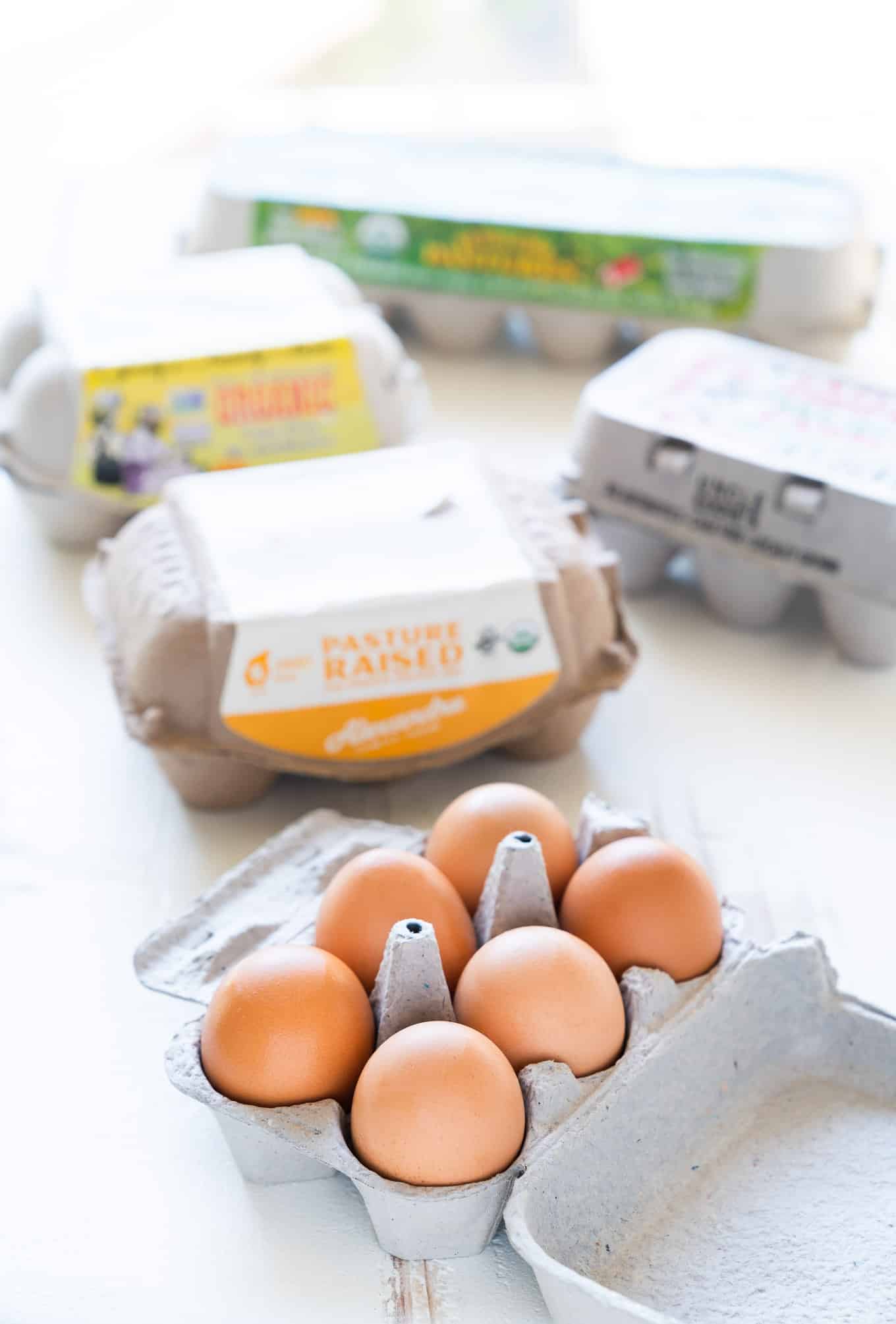This post explains how to choose which eggs to buy at the store and understand all the different terms printed on egg cartons. With detailed definitions of what each label means (explaining the difference between cage-free, free-range, pasture-raised eggs as well as organic, vegetarian, non-GMO, no hormones, no antibiotics, soy free and more).
I don’t know about you but when I walk into a grocery store nowadays, the egg section has one of the greatest variety of selections there is. Which, as a shopper, can induce a lot of anxiety and confusion.
When you’re in the produce section buying, say for example…zucchini, you’ll have (at most) maybe two choices – conventional zucchini or organic zucchini. But when you stand in front of the egg case, you don’t just have a choice of the quantity of eggs (half dozen, one dozen, two dozen) but the quality of the eggs too.
Cage-free, Organic, Free-Range, Pasture-Raised, No Antibiotics, No Hormones, Non-GMO, Soy-Free…and the list goes on. You’ve probably seen any or all of these terms printed on an egg carton at one time or another.
There’s a whole spectrum of labels staring back at you. They all seem to promise one humane treatment or another, and since there is no single government regulated standard for the safest or healthiest eggs – the burden falls to you to decide for yourself. Leaving you wondering…what do these terms even mean and how do I choose between them all?
So let’s do a deep dive on all-things-eggs and learn a little more so we can feel confident when we reach for the next dozen we bring home with us.
Let’s start with the big three – cage-free + free-range + pasture-raised eggs. These each deal with the way that chickens are raised, their living quarters, indoor vs. outdoor access, and how much space they have per bird.
Cage-free
This simply means that the chickens are raised without cages. However, this term alone doesn’t tell you much about their living conditions, diet, hormone / antibiotic use, or quality of life.
This term is regulated by the USDA but there are no space requirements. So it is possible that some cage-free farms offer their birds ample space, but there’s no way to tell from the term alone.
However, the HFAC (Human Farm Animal Care) does have space requirements for cage-free eggs to be “certified humane” - at least 1.5 square feet per hen. So if the carton reads “certified humane” on it, you will know a bit more about their living conditions.
These hens are more likely to be:
- raised indoors without access to outdoor spaces (with or without windows / using artificial or natural lighting)
- living on large factory farms in aviaries (large buildings or industrial barns)
- spending their lives in stressful, overcrowded conditions
- unable to graze on grasses or insects (and presumably fed only chicken feed)
It is important to note that they may also be from farms where the weather simply makes it impractical for the chickens to be raised with outdoor access year-round. But overall it is simply too difficult to discern the specifics from the term “cage-free” alone.
Free-range
This term means that the hens are cage-free and have continuous access to the outdoors during their laying cycle. This outdoor access could be fenced in or covered with protective netting. It tells you a little bit more about the chickens lifestyle and possibly about their diet – but not much more.
While this term is also regulated by the USDA, it also does not provide standards for what the outdoor space is, what the outdoor access is like, how often outdoor access is made available, or provide space requirements. So this could look like just a few doors leading to a fenced or screened in area – with dirt, cement, or grass. It doesn’t establish what the outdoor area will be like.
The HFAC’s space requirements for free-range, certified humane eggs are 2 square feet of outdoor space per bird.
Pasture-raised
This is about as close as it gets to creating the natural environment of a wild chicken, and cultivating a setting in which their natural behaviors can flourish. They have ample space to roam around outdoors, with access to a barn for shelter. So they are better able to engage in natural behaviors like dust-bathing and eating things like worms, insects, and wild plants like grass (with a diet supplemented with grain-based feed, usually corn).
Having a varied diet like this increases the overall nutritional content of the egg. You will notice that many pastured eggs have a richer, deeper colored yolk – sometimes almost orange in color. A number of studies in recent years have shown that pasture-raised eggs tend to have more:
- omega-3 fats
- beta carotene
- Vitamin A
- Vitamin D
- Vitamin E
This term is not currently regulated by the USDA – but in order to be pasture-raised and certified humane by HFAC, the birds would need to have at least 108 square feet of pasture per bird.
The practices and space available vary farm to farm – but many will print their own space requirements right on the box itself. Some regularly rotate their flocks to different pastures throughout the year, where others may just have one set area for them to roam and forage. Regular rotation is a traditional practice by farmers to 1) not ruin the land - allowing it time for regrowth & recovery and 2) provide the chickens a more rich and varied diet.
Next, let’s discuss a few terms that talk about how chickens are fed – organic + non-GMO + vegetarian + soy free + omega-3…
Organic
This term is regulated by the USDA. It means that these eggs must be laid by hens fed organic feed (produced without conventional pesticides or fertilizers). These hens must also be living in cage-free and free-range conditions.
Non-GMO
GMO stands for genetically modified organism, so non-GMO means the feed does not incorporate any genetically modified ingredients.
Vegetarian
This term can be confusing, especially because to many people the term “vegetarian” may imply that the chickens diet is healthy and natural.
However, chickens are not vegetarians – they are omnivores. So forcing these natural omnivores to eat a vegetarian diet is in a word – unnatural.
In the wild, chickens would derive protein from sources like worms, grasshoppers, other insects, and even small animals. I’ve read a few articles that even talk about farmers’ experiences in which the chickens not only become ill from a diet lacking in essential protein-based amino acids but also leads them to turn on each other in search for these vital nutrients – pecking at one another, causing injury and sometimes death.
It’s interesting to consider that decades ago many farmers would also feed their chickens things like animal scraps, organ meat, blood and bone meal.
The term “vegetarian” also conjures up images of vegetables, fresh produce, leafy greens etc. When in reality, vegetarian feed is generally comprised of corn or soy – sometimes fortified with synthetic versions of essential amino acids (like artificial methionine).
Soy-Free
I’ve seen this popping up more and more lately. Since even pasture-raised chickens can have a diet supplemented by chicken feed – consumers are growing increasingly curious about what is in the feed. Soy-free just means that the farmer does not use a chicken feed with soy in it.
Some people cannot (or choose not) to have soy in their diet for a variety of reasons. But one of which is that soy beans contain phytoestrogens (plant estrogens) called isoflavones – which may mimic the effect of estrogen in the body.
Omega-3
With our increasingly health conscious and health curious population – omega-3’s have become a big buzzword in wellness. Seeing this on egg cartons may indicate that the feed itself has flaxseed included in it, boosting the omega-3 content of the feed and possibly of the egg itself.
Finally, let’s chat about some miscellaneous terms – natural + farm fresh + no hormones + no antibiotics
Natural, Farm Fresh
I’m lumping these two terms together because they essentially mean…nothing. There’s no real regulation on these terms, but the assumption would be that these chickens are being raised naturally, fed naturally, and that your eggs are being freshly rounded up from the farm direct to your grocery shelf. More akin to marketing language than technical terms about the way a bird is or is not raised.
No Hormones
It is against the law to give hormones to poultry (egg-laying hens included) as well as to pork or goats.
So this term is essentially meaningless too. Adding the wording “no hormones” is akin to a brand boasting about doing something it is already bound by law to do.
It does not mean that those who do not print it on the carton are giving their chickens hormones. But I imagine it has made many a shopper question the surrounding cartons that didn’t declare this claim on their packaging.
No Antibiotics
This claim can only be made by egg producers who don’t give their birds antibiotics in feed or in water during their laying process. This one bears paying attention to - since companies that produce conventional eggs are allowed to use FDA approved antibiotics on their flocks.
It’s important to note that those producing organic eggs must be antibiotic-free according to regulations. So if you buy organic, you will automatically be buying antibiotic-free eggs as well.
Whew. If you made it through that list then you are a champ, my friend. THANK YOU for your curiosity and for caring enough to do that deep dive with me!
Something you probably picked up on in the definitions of these terms is the flexibility (or sometimes all out vagueness) inherent in each of them.
If after reading this you’re still wondering what the BEST choice would be, jump on over to my related post "Are Pasture-Raised Eggs Better For You?"









Grace says
your reports also do not mention that free range chickens also eat their own poop, dead rodents etc...they eat everything. I would prefer a balanced diet good for the chickens.